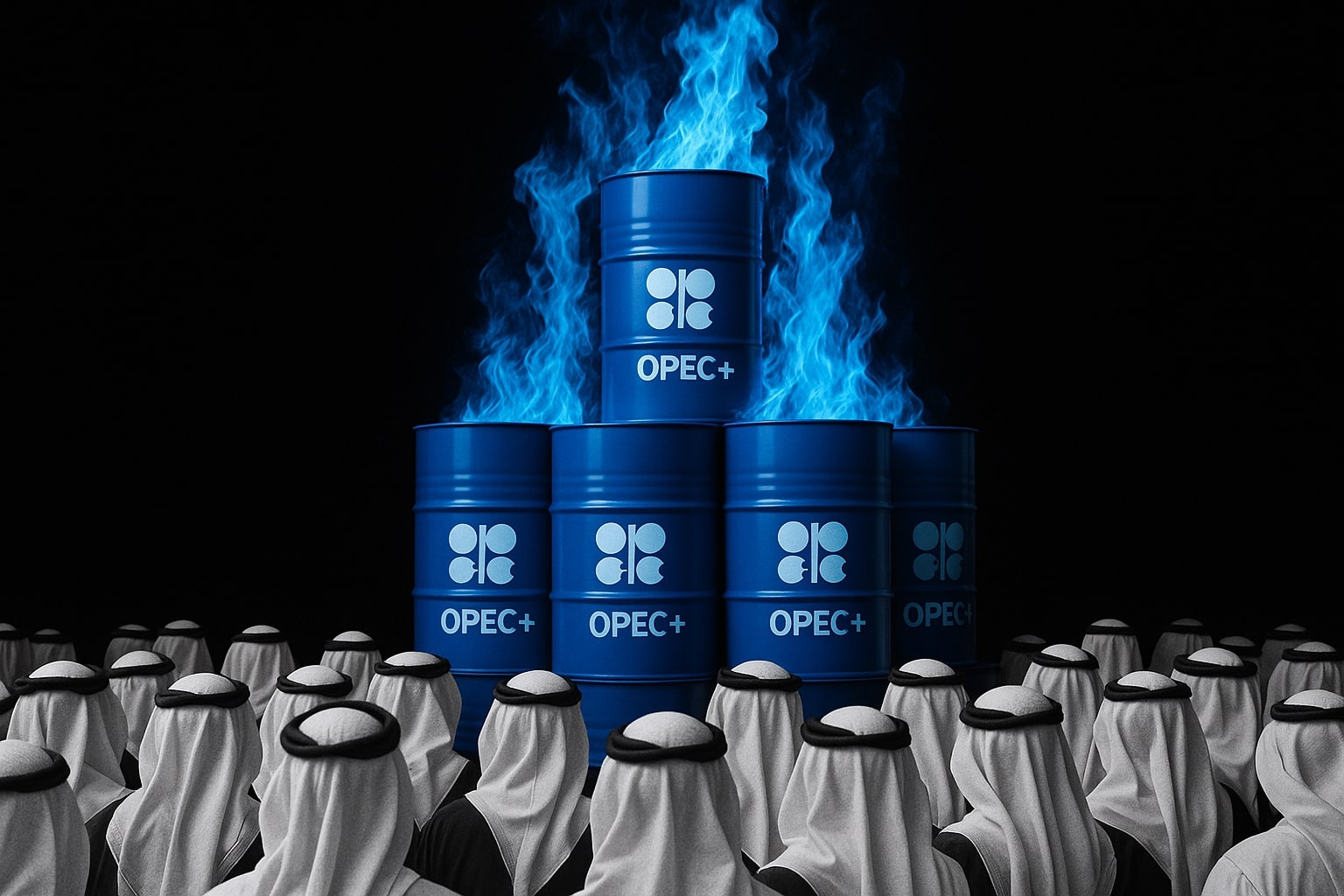
Natural Gas Price Forecast - NG=F Surges to $4.32 as U.S. LNG Exports Hit Record Levels and Storage Tightens
Record American LNG shipments, colder U.S. forecasts, and shrinking EIA storage inject fresh momentum into Natural Gas (NG=F), signaling a breakout toward $5 | That's TradingNEWS
Natural Gas (NG=F) – Breakout Momentum Builds as U.S. LNG Exports Hit Record Highs and Storage Tightens Into Winter
The natural gas market has erupted into one of the most aggressive reversals of 2025, shattering a year-long downtrend and flipping sentiment decisively bullish as prices surged beyond $4.30 per MMBtu, the highest level since March. The move comes amid record-breaking U.S. LNG exports, intensifying winter demand, and a sharp contraction in storage builds that confirm a fundamental tightening in supply. Natural Gas Futures (NG=F) are now trading near $4.32, up more than 34% over the past three months, while oil benchmarks such as WTI and Brent have tumbled by roughly 12%, underscoring the rotation of capital and profitability from crude oil to gas-linked assets.
Technical Reversal Confirms Structural Shift
The technical landscape for NG=F shows a clean, textbook reversal. The breakout through the $3.40 resistance, which capped rallies since February, ended nearly a year of descending price action. The commodity reclaimed its 20-day, 50-day, and 100-day EMAs, flipping them into support for the first time since 2024. The Supertrend indicator has turned bullish, confirming an upward shift in medium-term momentum. The $3.35–$3.00 range now acts as a powerful demand base built through months of accumulation, while the next major resistance sits at $4.50–$4.90, a zone that halted rallies last winter. Volume expansion during the breakout confirms institutional participation, not just speculative noise. If pullbacks occur, buyers are expected to defend $3.70–$3.90, keeping the uptrend intact. The year-long compression phase has transitioned into expansion, and the technical evidence supports a durable move toward $5.00 by early 2026.
EIA Storage Data Reinforces Bullish Case
The U.S. Energy Information Administration (EIA) reported a modest 33 billion cubic feet (Bcf) injection for the week ending October 31, lifting total working gas storage to 3,915 Bcf—just 162 Bcf (4.3%) above the five-year average. This was the smallest build since August and below the 42 Bcf five-year seasonal norm, signaling the end of the injection season. Market expectations were centered around 31 Bcf, and the data confirmed a tighter-than-expected balance. Futures held firm after the release, with the December contract climbing to $4.319 per MMBtu, extending gains by 2.1% on the day. Analysts noted that as injection season winds down and cold fronts intensify, the next storage updates are likely to shift toward withdrawals, accelerating price support through December and January.
LNG Export Records Redefine U.S. Supply Balance
The core driver of this surge lies in unprecedented U.S. LNG export strength. According to LSEG and Trading Economics data, LNG export flows averaged 16.6 billion cubic feet per day (Bcf/d) in October—an all-time record—while November shipments are projected to hit 17.2 Bcf/d across eight major export terminals. This surge in export demand has tightened the domestic market, even as U.S. production reached a record 109 Bcf/d. Europe has absorbed roughly 69% of these volumes, with Asia accounting for the rest, as Russian pipeline supply remains unreliable and EU storage facilities near maximum utilization. LNG demand remains 1 Bcf/d above October’s average, according to EBW Analytics, with flows through the Plaquemines LNG terminal now accounting for nearly 20% of total U.S. export capacity—the fastest ramp-up in American LNG history.
The Plaquemines project, operational for just over a year, has redrawn U.S. gas flow dynamics, boosting prices east of Henry Hub and creating regional tightness as Gulf Coast pipelines approach full utilization. At the same time, Mexico’s imports of U.S. natural gas reached 6.545 Bcf/d as of November 5, led by South Texas at 4.207 Bcf/d, reinforcing North America’s integrated energy dependency. The Dallas Federal Reserve warned in a recent analysis that Mexico’s increasing reliance on U.S. gas could expose it to cross-border price shocks if U.S. domestic supply tightens.
Weather and Seasonal Factors Add Momentum
The Weather Prediction Center forecasts Arctic air masses sweeping across the central and eastern United States, dropping temperatures 10–15°F below average early next week. This forecast is expected to lift gas demand by as much as 18 Bcf/d between Friday and Monday, according to EBW Analytics. The National Oceanic and Atmospheric Administration’s early-winter models show below-average temperatures dominating the Midwest and Northeast through December, ensuring sustained heating demand. With natural gas powering roughly 40% of U.S. electricity, every 1°F drop in national temperature can increase consumption by 1.5–2.0 Bcf/d—numbers that underscore how weather volatility amplifies current price momentum.
Europe and Asia Tighten LNG Competition
In Europe, the Dutch TTF benchmark has slipped 0.7% to €31.58/MWh amid strong LNG arrivals, yet beneath the surface, speculative shorts dominate. Investment funds reduced long exposure last week, creating a large gross short position that could unwind sharply if temperatures in Northern Europe plunge. Analysts at ING warn that despite inventories above 95%, the “large gross short” leaves the market vulnerable to any winter supply shock. In Asia, Japan and South Korea are securing additional U.S. cargoes ahead of projected January temperature drops, with Chinese interest also reigniting. Beijing’s energy policy pivot has resurfaced negotiations over the $44 billion Alaska LNG project, which could supply up to 20 million tonnes per year once operational. President Trump confirmed renewed talks with President Xi Jinping, calling the deal “a very large-scale energy transaction.”
Geopolitical Leverage and LNG Infrastructure Race
Natural gas is now the United States’ most strategic export commodity. The White House continues to push for expanded LNG infrastructure as a pillar of transatlantic energy policy. ExxonMobil recently expanded its offshore gas ventures in Greece, connecting to the Vertical Corridor pipeline that links Greece, Bulgaria, Romania, and Ukraine—cementing U.S. gas within Europe’s diversification strategy. The record 29.5 million tonnes per year of new long-term LNG contracts signed by U.S. producers in 2025—four times last year’s total—illustrates the structural evolution of gas from a domestic commodity to a globalized, geopolitically priced asset.
Read More
-
FDVV ETF Surges 129% in 5 Years — Fidelity’s Dividend-Tech Hybrid Trades Near $55.46 with 3.10% Yield
06.11.2025 · TradingNEWS ArchiveStocks
-
Ripple’s XRP ETFs XRPI & XRPR Eye $25 as U.S. Approval Nears — Institutional Filings Ignite Massive Market Shift
06.11.2025 · TradingNEWS ArchiveCrypto
-
Oil Price Forecast - WTI and Brent Crude Retreat Below Key Levels as Saudi OSP Cuts
06.11.2025 · TradingNEWS ArchiveCommodities
-
USD/JPY Price Forecast - Yen Consolidates Around 153.60 as Range Breakout Setup Drive Market Focus
06.11.2025 · TradingNEWS ArchiveForex
Production, Demand, and Market Mechanics
Domestic production remains robust at 109 Bcf/d, yet steady demand growth and export surges have neutralized prior oversupply fears. The balance is tightening, with supply increases plateauing while total consumption—including LNG and pipeline exports—pushes above 120 Bcf/d on cold days. Analysts at Natural Gas Intelligence highlight that “the U.S. gas market has entered a structurally higher demand phase,” where storage injections will increasingly undershoot averages. A year-end forecast from Trading Economics places NG=F at $4.28 by Q4 2025 and $5.14 by November 2026, reflecting a gradual rise consistent with sustained export growth.
Investor Behavior, Speculation, and Volatility Outlook
Speculative positioning has surged alongside fundamentals. Hedge funds and commodity traders have accumulated aggressive long exposure since mid-October, betting on a winter squeeze. This has driven implied volatility on Henry Hub contracts to 37.5%, the highest since early 2023. Over the past week, open interest expanded by 7%, primarily in the December–January spread, suggesting traders expect price acceleration through early winter. The oil-to-gas price ratio has fallen to its lowest level since late 2022, signaling capital rotation toward natural gas equities such as Cheniere Energy (NYSE:LNG), EQT Corporation (NYSE:EQT), and Chesapeake Energy (NASDAQ:CHK). Each stands to benefit from rising margins and favorable pricing spreads across their LNG exposure portfolios.
Corporate and Infrastructure Expansion
LNG infrastructure growth remains the centerpiece of the long-term bull thesis. The United States now operates eight active export terminals, with an additional three in construction and seven proposed. Projects such as Golden Pass, Driftwood, and Alaska LNG could collectively expand export capacity by 60 million tonnes per year by 2028. This buildout aligns with global decarbonization goals while simultaneously entrenching U.S. influence in European and Asian energy security. Investors should note that every 1 Bcf/d of new export capacity represents roughly 0.9% of total U.S. production—meaning the current 17 Bcf/d export rate absorbs nearly 16% of national output.
Price Outlook and TradingNews Decision
At $4.32 per MMBtu, natural gas has entered a critical zone where technical strength aligns with tightening fundamentals. A clean break above $4.50 would open the path toward $4.90–$5.10, marking the highest levels since January 2022. Dips toward $3.70–$3.90 are likely to attract institutional buyers, with $3.35 forming a structural floor. Traders remain focused on early-December temperature forecasts, LNG cargo flow data, and upcoming EIA reports, which are expected to show the first weekly withdrawals of the season. Considering the synchronized bullish triggers—record exports, tightening storage, cold weather, and global demand—TradingNews maintains a BUY rating on Natural Gas (NG=F), with a 12-month target of $5.15 per MMBtu and a bullish near-term bias into Q1 2026.



















